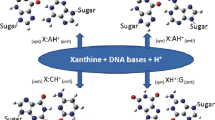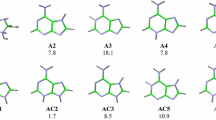Abstract
Water-assisted proton-catalyzed hydrolytic deamination of adenine to produce hypoxanthine has been studied using density functional theory method. Because adenine could be protonated at N1, N3, N7 and N10, four pathways initiated from the four different protonated adenines have been investigated. The first step of the four pathways is the nucleophilic attack of water with an assistant water to form a tetrahedral structure complex, and this is the rate-determining step. Including solvent effects decreased the relative energies of stationary points but have little effect on the structures. Pathway A is preferred due to the lowest energy barrier, and the relative free energy is 28.9 kcal/mol in vacuo. The outcomes show that adenine deamination under acidic condition is much easier to occur than under neutral condition due to lower energy barriers. The total atomic charge of C5 in the initial intermediate is correlated with the ease of deamination reaction. The more positive C5 atom is, the easier the deamination reaction is.








Similar content being viewed by others
References
Sun X, Lee JK (2007) J Org Chem 72:6548–6555
Almatarneh MH, Flinn CG, Poirier RA, Sokalski WA (2006) J Phys Chem A 110:8227–8234
Almatarneh MH, Flinn CG, Poirier RA (2008) J Chem Inf Model 48:831–843
Labet V, Morell C, Grand A, Toro-Labbé A (2008) J Phys Chem A 112:11487–11494
Labet V, Grand A, Morell C, Cadet J, Eriksson LA (2008) Theor Chem Acc 120:429–435
Labet V, Morell C, Cadet J, Eriksson LA, Grand A (2009) J Phys Chem A 113:2524–2533
Zhang A, Yang B, Li Z (2007) J Mol Struct Theochem 819:95–101
Zhu C, Meng F (2009) Struct Chem 20:685–691
Zheng H, Meng F (2009) Struct Chem 20:943–949
Jordan DO (1960) The chemistry of nucleic acids. Butterworths, Washington, DC, p 65
Shapiro R, Klein RS (1966) Biochemistry 5:2358–2362
Becke AD (1988) Phys Rev A 38:3098–3100
Lee C, Yang W, Parr RG (1988) Phys Rev B 37:785–789
McLean AD, Chandler GS (1980) J Chem Phys 72:5639–5648
Raghavachari K, Binkley JS, Seeger R, Pople JA (1980) J Chem Phys 72:650–654
Toro-Labbé A (1999) J Phys Chem A 103:4398–4403
Rincón E, Toro-Labbé A (2007) Chem Phys Lett 438:93–98
Furmanchuk A, Leszczynski J (2008) J Sulfur Chem 29:401–413
Cappelli C, Corni S, Mennucci B, Tomasi J, Cammi R (2005) Int J Quant Chem 104:716–726
Adhikary A, Kumar A, Becker D, Sevilla MD (2006) J Phys Chem B 110:24171–24180
Cances E, Mennucci B, Tomasi J (1997) J Chem Phys 107:3032–3041
Rappé AK, Casewit CJ, Colwell KS, Goddard WA III, Skiff WM (1992) J Am Chem Soc 114:10024–10035
Baboul AG, Curtiss LA, Redfern PC (1999) J Chem Phys 110:7650–7657
Curtiss LA, Raghavachari K (1998) J Chem Phys 109:7764–7776
Pople JA, Head-Gordon M, Raghavachari K (1987) J Chem Phys 87:5968–5975
Head-Gordon M, Pople JA, Frisch MJ (1988) Chem Phys Lett 153:503–506
Tang YZ, Sun JY, Sun H, Pan YR, Wang RS (2008) Theor Chem Account 119:297–303
Frisch MJ, Trucks GW, Schlegel HB, Scuseria GE, Robb MA, Cheeseman JR, Montgomery JA Jr, Vreven T, Kudin KN, Burant JC, Millam JM, Iyengar SS, Tomasi J, Barone V, Mennucci B, Cossi M, Scalmani G, Rega N, Petersson GA, Nakatsuji H, Hada M, Ehara M, Toyota K, Fukuda R, Hasegawa J, Ishida M, Nakajima T, Honda Y, Kitao O, Nakai H, Klene M, Li X, Knox JE, Hratchian HP, Cross JB, Adamo C, Jaramillo J, Gomperts R, Stratmann RE, Yazyev O, Austin AJ, Cammi R, Pomelli C, Ochterski JW, Ayala PY, Morokuma K, Voth GA, Salvador P, Dannenberg JJ, Zakrzewski VG, Dapprich S, Daniels AD, Strain MC, Farkas O, Malick DK, Rabuck AD, Raghavachari K, Foresman JB, Ortiz JV, Cui Q, Baboul AG, Clifford S, Cioslowski J, Stefanov BB, Liu G, Liashenko A, Piskortz P, Komaromi I, Martin RL, Fox DJ, Keith T, Al-Laham MA, Peng CY, Nanayakkara A, Challacombe M, Gill PMW, Johnson B, Chen W, Wong MW, Gonzalez C, Pople JA (2004) Gaussian 03, revision D.01. Gaussian Inc, Wallingford, CT
Mirkin SM (1995) Annu Rev Biophys Biomol Struct 24:319–350
Wu R, McMahon TB (2007) J Am Chem Soc 129:569–580
Fuentes-Cabrera M, Sumpter BG, Šponer JE, Šponer J, Petit L, Wells JC (2007) J Phys Chem B 111:870–879
Liu H, Gauld JW (2008) J Phys Chem B 112:16874–16882
Close DM, Crespo-Hernández CE, Gorb L, Leszczynski J (2008) J Phys Chem A 112:12702–12706
Sousa SF, Fernandes PA, Ramos MJ (2007) J Phys Chem A 111:10439–10452
Lindahl T, Nyberg B (1974) Biochemistry 13:3405–3410
Acknowledgments
This work was supported by Scientific Research Reward Fund for Excellent Young and Middle-Aged Scientists of Shandong Province (Grant No. 2008BS02014).
Author information
Authors and Affiliations
Corresponding author
Electronic supplementary material
Below is the link to the electronic supplementary material.
Rights and permissions
About this article
Cite this article
Wang, H., Meng, F. Theoretical study of proton-catalyzed hydrolytic deamination mechanism of adenine. Theor Chem Acc 127, 561–571 (2010). https://doi.org/10.1007/s00214-010-0747-1
Received:
Accepted:
Published:
Issue Date:
DOI: https://doi.org/10.1007/s00214-010-0747-1




